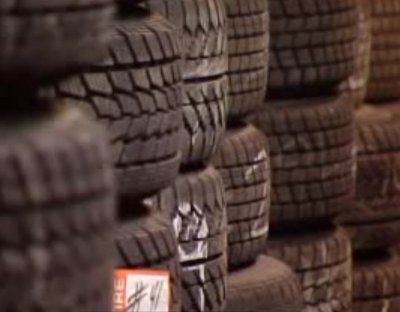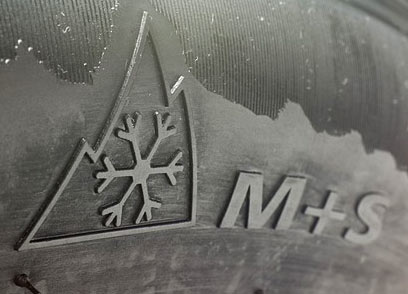
Your car or truck was most likely delivered with all-season tires. If you’ve had them on the vehicle for two or three years, they’re probably inadequate for winter. Even brand new, an all-season tire will not approach the performance of a dedicated snow tire in slush or on ice.
Here’s what you need to know before you go out to buy winter tires:
Tread depth
The minimum tread depth you need at the start of winter is 6/32” ( 4.8 millimeter). For an approximate idea, take a conventional Canadian quarter and stick the caribou, nose first, into the deepest part of the tread. The tip of the nose should be buried; if not, the tread depth is inadequate to see you through the winter.
Tire pressure
Tire pressure is critical to handling, especially for vehicles equipped with low profile tires. Check pressures once a month, except in very cold weather when tire valves can freeze. It’s important to adjust tire pressure in the autumn, because the drop in temperature causes the air pressure in tires to go down significantly: tire pressure is reduced by 1.7 PSI (0.12 bar) for every drop of 10°C in temperature. If you don’t know what pressure to set the tires to, look for a yellow label posted by the manufacturer in the door opening, glove compartment or console bin; the owner’s manual also contains this information. And don’t forget to check the spare. The small space-saver spare in the trunk of most cars has to be filled to about twice the pressure of the other tires; it probably has not been checked since the day your vehicle left the factory!
Where to place winter tires
Winter tires on most vehicles belong on all four wheels. Putting two winter tires on a front-wheel drive vehicle creates an unstable, unbalanced vehicle. The same holds for all-wheel drive vehicles. Rear-wheel drive vehicles need winter tires at the front as well for maximum braking performance and steering ability in winter conditions. If you own a vehicle and are not prepared to pay the additional cost of four winter tires, consider purchasing all-season tires for year-round use.
Two winter tires can be installed on the rear wheels of two-wheel drive pickup trucks, but it is preferable to mount them on all four wheels.
Winter vs all-season
An all-season tire is adequate for mild winter conditions prevalent in southern Ontario, particularly when the tire is new. The best indicator for the vehicle owner is past experience. If you plan to keep the vehicle more than three years, the purchase of snow tires makes sense, as they replace a future set of all-season tires you will have to buy anyway.
Three principal characteristics distinguish a winter tire from an all-season tire. The winter tire is made of a softer, spongier rubber that grips better in colder weather. (That’s also why it has to be removed for summer use to avoid wearing it out.) The rubber used in a summer tire becomes hard at 10 C. An all-season tire will stay flexible to –10 Celsius, and the rubber on a winter tire should stay flexible to – 30 C.
The grooves in the tire are deeper, and its large blocky treads bite into snow more aggressively.
A winter tire offers significant safety advantages over an all-season tire. Braking on ice is better. In comparison tests, the best winter tires stopped between 30 and 60 feet shorter than all-season tires from 50km/h. Performance is enhanced in deep snow and slush. You’re less likely to get stuck in a parking spot or to be unable to start on a steep hill. The advantages become greater as tires wear and the all-season model starts to perform like the proverbial banana peel.
The disadvantages of winter tires are the additional purchase cost and inconvenience related to storage and twice-yearly changeover.
Pourquoi utiliser des pneus d’hiver?
Le pneu d’hiver est fait d’une gomme de caoutchouc plus tendre et plus spongieuse qui adhère mieux à la chaussée par temps froid. C’est pourquoi il faut ôter les pneus d’hiver en été pour éviter de les user. Le type de gomme utilisé dans les pneus d’été durcit à 10 degrés Celsius. Un pneu quatre saisons demeurera souple jusqu’à -10° Celsius tandis que la gomme d’un pneu d’hiver doit demeurer souple jusqu’à -30°C.
La rainure du pneu est plus profonde et la sculpture à blocage mord dans la neige avec plus de vigueur.
Le pneu d’hiver présente des avantages sur le plan de la sécurité par rapport à un pneu quatre saisons. Le freinage sur la glace est meilleur. Dans les essais comparés réalisés à 50km/heure, les meilleurs pneus d’hiver ont gagné de 30 à 60 pieds en distance de freinage par rapport aux pneus quatre saisons. Le rendement est meilleur dans la neige profonde et la neige fondante. Vous risquez moins de rester pris dans une place de stationnement ou d’être incapable de démarrer dans une pente raide. Avec le temps, les avantages deviennent plus évidents lorsque le pneu quatre saisons commence à se comporter comme la proverbiale pelure de banane.
The mountain and the snow flake

The “mountain and snow flake” standard was created because of the inadequacy of the “M+S” (mud and snow) symbol, which is overused by the tire industry and for which no standard exists. This absence of objective criteria resulted in an effort by the industry that also involved government participation to develop a meaningful standard.The Rubber Association of Canada and its American counterpart devised a stricter snow traction standard for winter tires that was implemented during the winter of 2001-2002. Tires that meet this standard display a small symbol on their sidewalls depicting a snowflake on a mountain. The compliance of a tire with this standard is evaluated by performing a standardized test on packed snow; tires that achieve a traction index higher than 110 (compared to a reference tire with an index of 100) qualify for the logo.
Recently, a new class of year-round tire called All-Weather has appeared. These tires use a hybrid tread that manages to meet the winter tire traction requirement in snow, combined with the harder compound more typical of a conventional all-season tire. The compromise? Ice traction is not covered by the snow tire standard, an unfortunate ommission that the tire industry and governments should correct. On ice, the hard rubber compund of a year round All-Weather tire will not equal a dedicated winter tire.
Should I change wheels for winter?
The purchase of inexpensive steel wheels saves the cost of mounting and dismounting tires twice a year. It also prevents damage to the tire during installation and saves fragile alloy wheels on many cars from the corrosive effect of salt used in winter. The additional cost of about $50 per wheel is recovered within three years from installation savings.
The owners of cars equipped with low profile tires should definitely consider switching to higher profile winter tires mounted on wheels of a smaller diameter. Low profile winter tires are less effective and tend to facilitate the accumulation of snow within the wheels. For more information on downsizing the wheels on your vehicle, check the section about minus one and minus two conversions in this guide.
Avoid multi-application aftermarket wheels, including wheels that have had the center hole machined (rough finish). The imprecise fit of this type of wheel can cause the vehicle to shake at speed and causes excess stress on the wheel studs which can eventually shear. These wheels are usually offered by independent tire retailers (who can also often provide you with vehicle-specific wheels), but new car dealerships sell them, too. Wheels designed specifically for your car may cost a bit more, but they are worth it.
Winter tire characteristics
The best winter tires offer superior adhesion on ice in deep snow, with a soft comfortable ride. Handling is less precise than summer tires.
European winter tires are generally more performance oriented. Handling is crisper and stability superior at high speed, but adhesion on ice is not as good.
